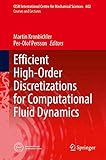Efficient High-Order Discretizations for Computational Fluid Dynamics [electronic resource] / edited by Martin Kronbichler, Per-Olof Persson.
Contributor(s): Kronbichler, Martin [editor.] | Persson, Per-Olof [editor.]
| Persson, Per-Olof [editor.] | SpringerLink (Online service)
| SpringerLink (Online service) .
.
Material type:  BookSeries: CISM International Centre for Mechanical Sciences, Courses and Lectures: 602Publisher: Cham : Springer International Publishing : Imprint: Springer, 2021Edition: 1st ed. 2021.Description: VII, 311 p. 88 illus., 56 illus. in color. online resource.Content type: text Media type: computer Carrier type: online resourceISBN: 9783030606107.Subject(s): Fluid mechanics
BookSeries: CISM International Centre for Mechanical Sciences, Courses and Lectures: 602Publisher: Cham : Springer International Publishing : Imprint: Springer, 2021Edition: 1st ed. 2021.Description: VII, 311 p. 88 illus., 56 illus. in color. online resource.Content type: text Media type: computer Carrier type: online resourceISBN: 9783030606107.Subject(s): Fluid mechanicsThe Discontinuous Galerkin Methods: Derivation and Properties -- High-Performance Implementation of Discontinuous Galerkin Methods with Application in Fluid Flow. Construction of Modern Robust Nodal Discontinuous Galerkin Spectral Element Methods for the Compressible Navier-Stokes Equations -- p-Multigrid High-Order Discontinuous Galerkin Solution of Compressible Flows -- High-Order Accurate Time Integration and Efficient Implicit Solvers -- An Introduction to the Hybridizable Discontinuous Galerkin Method -- High-Order Methods for Simulation in Engineering.
The book introduces modern high-order methods for computational fluid dynamics. As compared to low order finite volumes predominant in today's production codes, higher order discretizations significantly reduce dispersion errors, the main source of error in long-time simulations of flow at higher Reynolds numbers. A major goal of this book is to teach the basics of the discontinuous Galerkin (DG) method in terms of its finite volume and finite element ingredients. It also discusses the computational efficiency of high-order methods versus state-of-the-art low order methods in the finite difference context, given that accuracy requirements in engineering are often not overly strict. The book mainly addresses researchers and doctoral students in engineering, applied mathematics, physics and high-performance computing with a strong interest in the interdisciplinary aspects of computational fluid dynamics. It is also well-suited for practicing computational engineers who would like to gain an overview of discontinuous Galerkin methods, modern algorithmic realizations, and high-performance implementations.


There are no comments for this item.